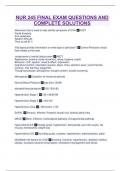NUR 245 FINAL EXAM QUESTIONS AND
COMPLETE SOLUTIONS
Mnemonic that is used to help identify symptoms of CVA ✅FAST
Facial drooping
Arm weakness
Speech difficulty
Time to call 911!
Vital signs provide information on what type of perfusion? ✅Central Perfusion: blood
flow related to the heart
components of mental status exam ✅ABCT
Appearance: posture, body movement, dress, hygiene, pupils
Behavior: LOC, speech, mood & affect, expression
Cognitive function: orientation (person, place, time), attention span, recent/remote
memory, new learning, judgement
Thought processes: perceptions, thought content, suicide screening
Menopause ✅Cessation of menstrual periods
Normal Blood Pressure ✅less than 120/80
elevated blood pressure ✅120-129/<80
Hypertension Stage 1 ✅130-139/80-89
Hypertension Stage 2 ✅>140/>90
Hypertensive crisis ✅>180 and/or >120
SAPAL ✅Sensory, Afferent, Posterior dorsal root, AnteroLateral tract
MECE ✅Motor, Efferent, Corticospinal pathway, Extrapyramidal pathway
Hypovolemia S/S ✅thready pulse, hypotension, tachycardia, poor skin turgor, dry
mucous membranes, weight loss
Hypervolemia S/S ✅Bounding pulse, crackles, hypertension, edema/ascites, pallor
Modifiable risk factors for CAD ✅Smoking, inactivity, hypertension, diabetes mellitus,
obesity, excessive alcohol consumption, cholesterol management and stress.
, Nonmodifiable risk factors for CAD ✅Age
Gender
Ethnicity
Family history
Genetic predisposition
Mnemonic to help prioritize patients ✅ABC
airway
breathing
circulation
Lordosis ✅exaggerated curvature of the lumbar spine (sway-back condition)
kyphosis ✅excessive outward curvature of the thoracic spine, causing hunching of the
back.
scoliosis ✅sideways curvature of the spine
2 ball and socket joints in the body ✅glenohumeral/shoulder joint
hip joint
Parts of the nursing process ✅A-D-P-I-E : Assessment, Diagnosis, Planning,
Intervention, Evaluation
subjective data ✅things a person tells you about that you cannot observe through your
senses; symptoms
Critical thinking ✅purposeful, result-oriented thinking, continually reevaluating, self-
correcting, striving to put the pieces together
Where do you check for vascular bruits during the abdominal assessment? ✅ARIF:
aorta, renal, iliac and femoral arteries
Wheezes ✅high-pitched squeaky sound on expiration
stridor ✅high-pitched inspiratory crowing caused by an upper airway obstruction
Plueral Friction Rub ✅creaking or grating sound from roughened , inflamed pleura
crackles ✅fine crackling or bubbling sounds, commonly heard during inspiration when
there is fluid in the alveoli; also called rales
What is BPH? Symptoms? ✅benign prostatic hyperplasia




